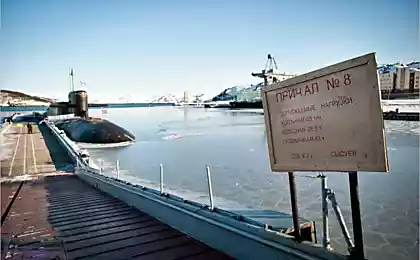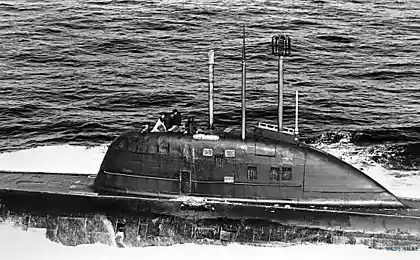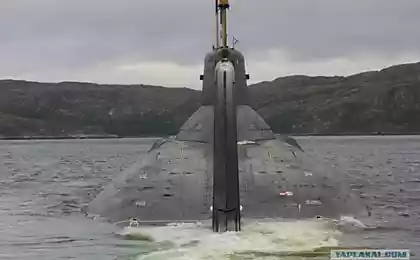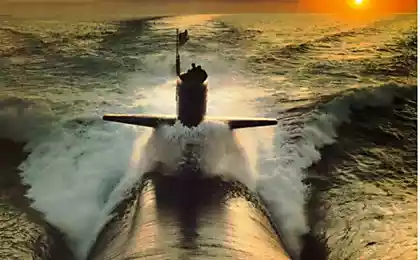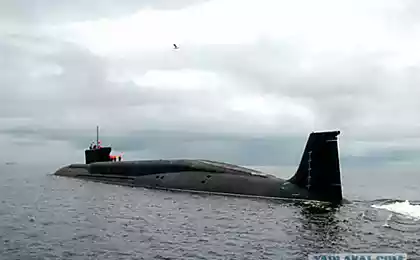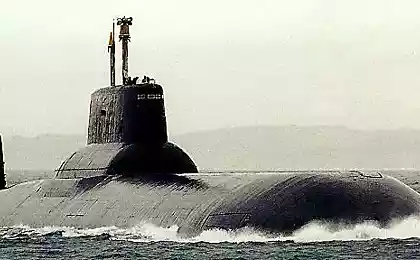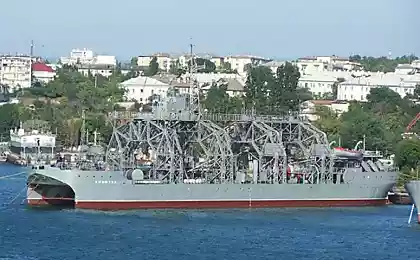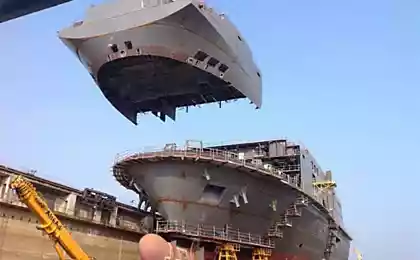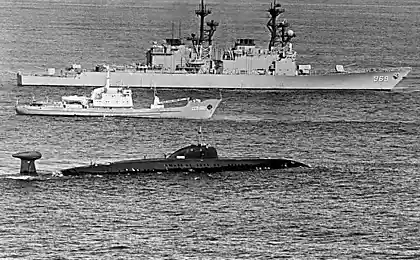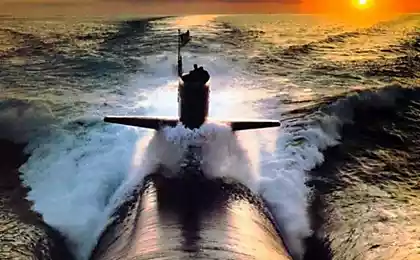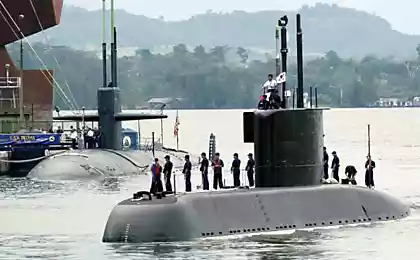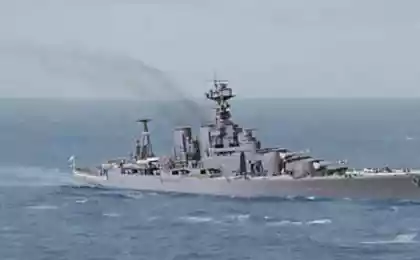1387
Evolution submarines
The idea of combat use of the underwater vessel was first proposed by Leonardo da Vinci. Subsequently, he destroyed his project, because he feared the devastating effects of submarine warfare. Sometimes among the inverse images of submarines is also called "gull", Zaporozhye Cossacks elongated boats that could be used in an inverted state.
The first real submarine took part in armed actions was set up in the United States Horace L. Hunley (HLHunley) during the Civil War Confederate Navy. It was a locomotive boiler, at both ends of which are mounted pointy tip. Immersion was carried out by filling the two ballast tanks fore and aft, which were blown to ascend hand pump, and for emergency ascent dumped iron ballast is fixed at the bottom. The propeller is rotated by the crankshaft eight sailors. Armament consisted of mines, enshrined in a long steel pole on the bow of the boat. Seeing entrance and exit of the crew of the boat were carried out through two small towers.
Horace L. Hunley Confederate Navy during

The First World War
In May 1899 at an international conference in The Hague, Russia, with the support of countries such as Germany, France, Italy, Japan and the United States has attempted to limit the creation of underwater weapons, which was thwarted by Britain.
English PL.Portsmut.Pervoe decade of the twentieth century.
During the First World War there were submarines with diesel engine for movement on the surface and electric motion to the water. It was connected to a diesel engine generator that produces electricity to recharge the batteries.
Accelerated development of the submarine fleet in World War I led to the fact that the submarine became a formidable weapon. During the war 600 submarine sank the Warring States 55 major warships (battleships and cruisers), 105 destroyers, 33 submarines. Total tonnage sunk merchant ships was approximately 19 million gross tons. Actions of German submarines in the sea lanes put England on the brink of defeat in the war.
English PL.Portsmut.Pervoe decade of the twentieth century.

German UC-1. The First World War

Mine (torpedo) compartment of the submarine during World War

At the end of the First World War was concluded on the need to interact submarines with surface ships of the squadron, so between the two world wars, mainly improved surface performance characteristics.
The Second World War
By the beginning of World War II in the Navy's leading maritime nations included the following number of submarines:
Germany - 57;
US - 99;
France - 77;
Italy - 105;
Japan - 56;
USSR - ~ 200 to 22.06.1941 - 211.
United Kingdom - 58;
During the war, all submarines of foreign countries (excluding the USSR) was sunk 4,330 vessels with a total carrying capacity of transport about 22, 1 million reg. ie, destroyed 395 warships, including 75 submarines, 17 aircraft carriers, 3 battleships, destroyers, 122 and 146 ships of other types. Died in 1123 submarines.
Submarines of the Navy sank 328 transports, 70 warships and 14 auxiliary ships of enemy with a general displacement 938 thou. Tons.
During World War II Submarines perform different tasks, but at relatively the same combat capabilities of their effectiveness has been mixed. In extreme conditions, in crowded and shallow areas, the presence of a major mine risk education and the strong development of ASW combat missions had a Soviet submarine.
L-23 - Soviet diesel-electric mine and torpedo submarines during the Second World War, the fourth ship of the series XIII-1938 of the "Leninist».
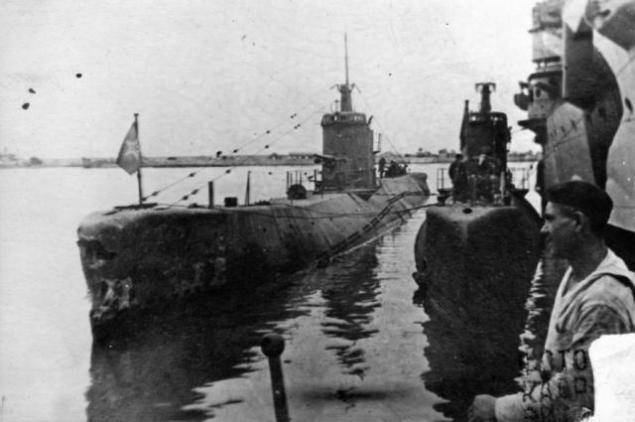
L-19 (Series XIII, A - "Leninist") - Soviet diesel-electric submarine minelayer of World War II.
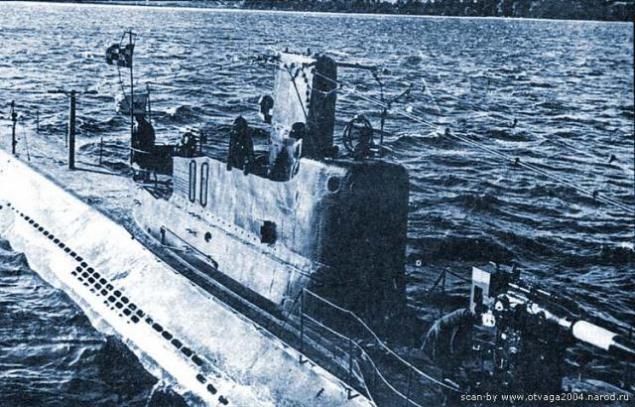
Submarines M - "Baby" - the type of Soviet submarines during the Second World War, the smallest submarines in the Soviet Union during this period. Submarines type "M" actively participated in the Great Patriotic War. Targeting near-coastal protection and marine bases, they were able to conduct successful operations even in the coast of the enemy in enemy harbors.
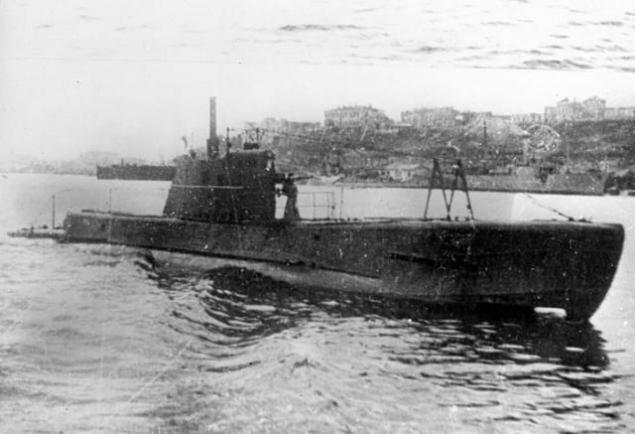

Submarines of WWII times other states:
American submarine, Type «Argonaut»

The German submarine series «VII»
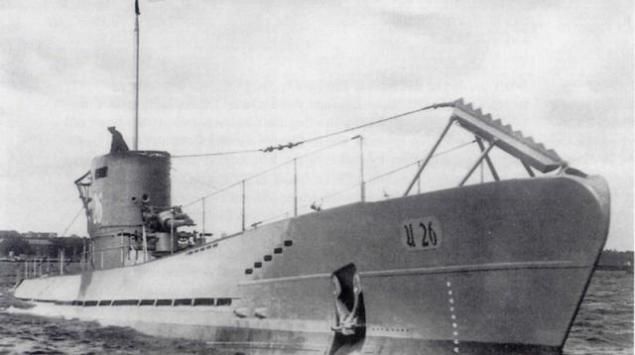
U-36 (died in 1939)

U-28 (died 17.3.1944), U-29 (flooded 5.5.1945), U-30 (flooded 5.5.1945)
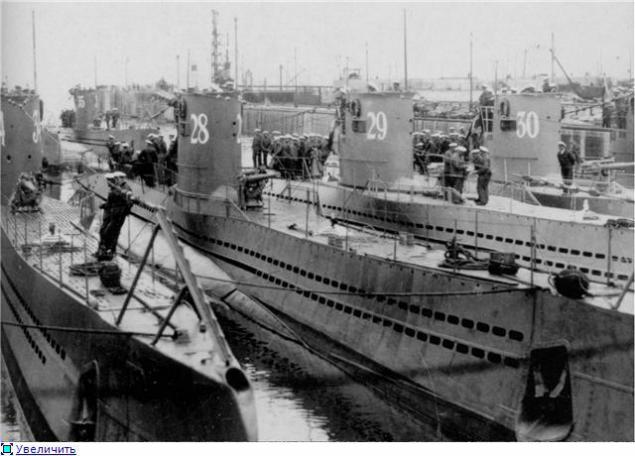
In his new capacity
Work on the creation of the Premier League were conducted at an accelerated pace. In 1948 the project was completed nuclear power plant and the contract for the design and construction of the experimental reactor, and in August 1949 approved the tactical and technical data of the first nuclear submarine, which was founded in June 1952 at a shipyard in Groton and named Nautilus. January 21, 1954 in the presence of US President Eisenhower's the Nautilus was launched, and January 18, 1955 was submitted for testing and the commander aired openly "Go under the nuclear engine».
USS Nautilus (SSN-571) - the world's first nuclear-powered submarine, launched in the US in 1954.
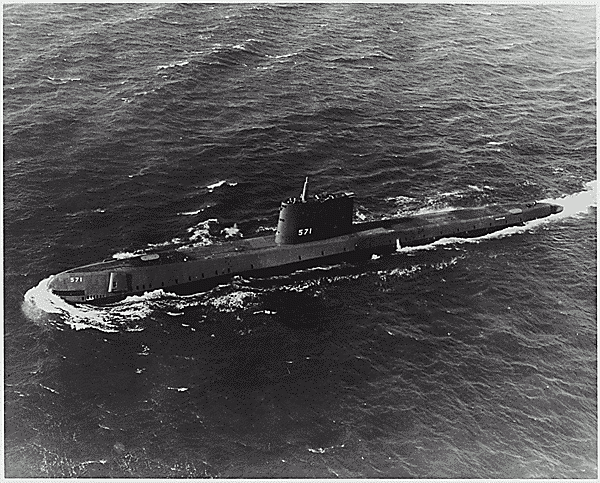
The first submarine is not only demonstrated their tactical advantages, but also put forward a number of problems. So, their displacement has increased about twice, and the cost is almost twenty times compared with diesel-electric submarines of the United States during World War II.
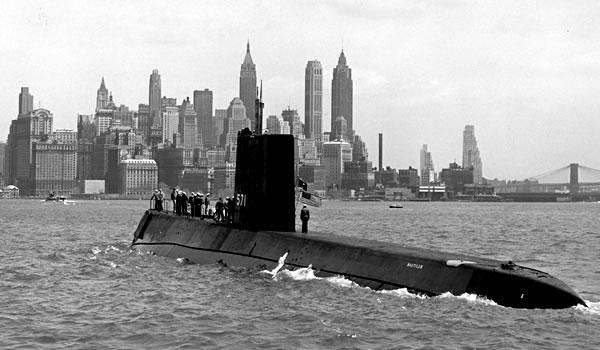
When you create the Premier League had, in principle, to change the approach to the choice of shape and size of the body, which for diesel-electric submarines were determined based on the regime of navigation on the surface. For Premier League, almost always under water, surface speed mode is episodic and, therefore, at its creation is necessary to strive for the greatest possible reduction in resistance of the boat submerged. Despite some progress in reducing the underwater resistance of diesel-electric. boats of the middle 40 - the beginning of the 50s, their body shape and size for the Premier League were not good. They require more drastic measures, as it was a submerged speed of 30 knots or more, in which the resistance of the water will "eat" a much greater share of the power plant capacity than diesel-electric boats with underwater speed of 10-15 knots. And the increase in capacity for every 1,000 kilowatt considering low specific mass indexes ETA was followed by an increase in the mass installation of about 80 tons.
In the USSR, the first nuclear submarine became known not without K-19.
"K-19" - was capable of carrying three nuclear ballistic missiles. The submarine was built in Sverdlovsk in record time and was a response to the emergence of the Soviet Union, the Americans missile submarine "George Washington».
Designing 658 project began in August 1956, CDB-18 under the direction of SN Kovalev. The basis was taken Project 627 multipurpose nuclear torpedo boats.
K-19 - the nuclear submarine project 658. For many boat had an accident in the Navy nickname "Hiroshima».



List of accidents and disasters at the K-19
Because of the accidents several people died in 1959, before the descent of the submarine into the water:
when painting holds a fire broke out, two people were killed;
after the resumption of paint work choked a female painter;
In 1961, when loading rockets into the mines was a sailor cap crushed mine and was killed.
April 12, 1961 the boat narrowly escaped a collision with the submarine USS «Nautilus» SSN-571, but due to a sharp decrease in the depth of the maneuver while crashing into the bottom. There was no significant damage.
3 July 1961 - an accident the reactor feed: the pressure drop in the primary circuit as a result of the gap in the first circuit control line between the pressure line and the sensor. As a result, the devices showed zero pressure, although there was a complete rupture. Eliminating accident subsequently cost the lives of eight people, all the rest of the crew received high doses of radiation.
November 15, 1969 - the collision submerged submarine USS Gato US Navy during the maneuver of changing the depth from 60 to 90 meters.
February 24, 1972 - Fire in the 8th and 9th compartments. Pribuksirovana on base. Killed 28 people on the boat and two rescuers. 12 sailors have been in prison in the 10th aft compartment 24 days without electricity, communications, food and with scarce water available from other compartments only air (intermittent). All survived.
15 August 1982 - in the repair in the battery compartment there was an electrical arc. Burned several people, one of them on August 20 at the hospital died.
Modern submarines
Modern submarines are used as a source of nuclear power plant, diesel motors, batteries, Stirling engines or fuel cells.
Submarine in the march
After the Second World War are known only two significant cases of submarine torpedoing a warship. December 9, 1971 during the Indo-Pakistani War Pakistani diesel submarine «Hangor» torpedoed Indian frigate «Khukri». May 2, 1982 during the Falklands War between Britain and Argentina, the British nuclear submarine «Conqueror» torpedoed the Argentine light cruiser "General Belgrano". In addition, the death of a South Korean corvette "Cheonan" March 26, 2010 took place, according to the conclusion of the commission to investigate the incident, as a result of North Korea's torpedoing of his submarine.
Nuclear submarine type «Vanguard.
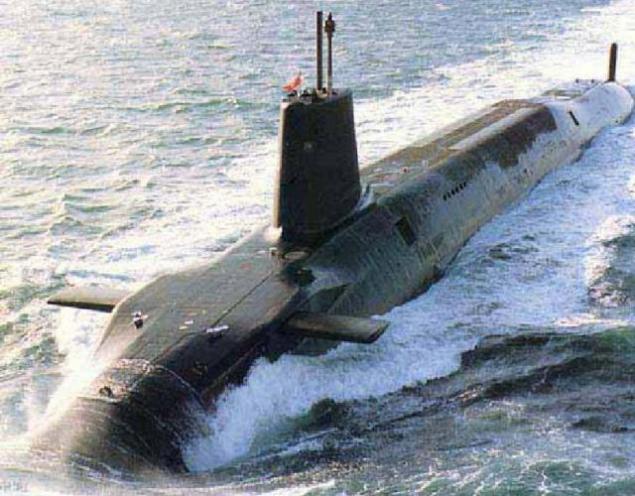
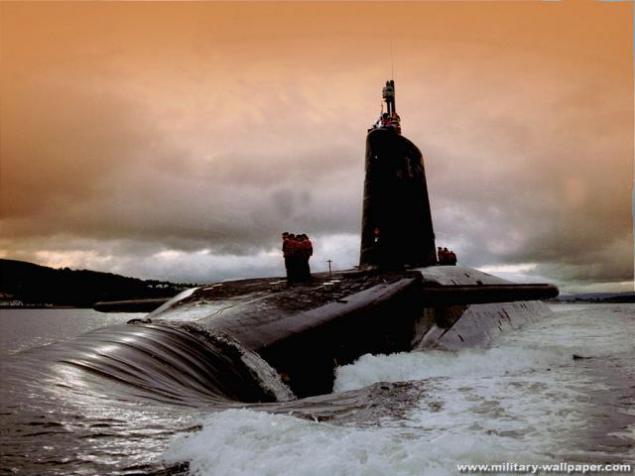
941 missile submarine "Typhoon.
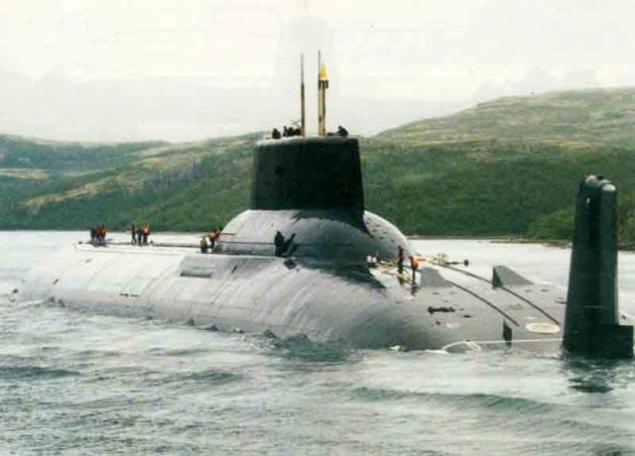

FACTS:
The most revolutionary submarine.
Project 705 - Lira
Submarine Project 705, 705K "Lira" - a series of Soviet submarines. High-speed single-shaft small boat with a titanium case had no analogues in speed and maneuverability, were designed to destroy enemy submarines. Difficulties in maintenance of submarines and the reduction of funding in connection with the beginning of perestroika led to the end of the career of these ships.
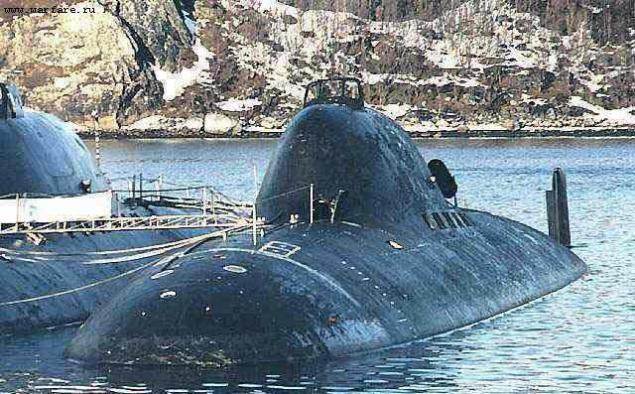
Maximum speed "Lear" is 41 knot. They are inferior in speed only decommissioned K-222 Project 661 "Anchar" which set a record speed of 44 knots 7;
For more than 20 years of service in the fight for survival has not lost a single man. None of the ships were lost;
"Lyra" could pursue any submarine and break away from any prosecution. On acceleration to full speed they needed only about 1 minute.
Speed Boat let her rip even many anti-submarine torpedoes.
The world's only serial project submarines with liquid metal reactor
On a boat this project achieved a record daily average travel speed ~ 41-42 knot.
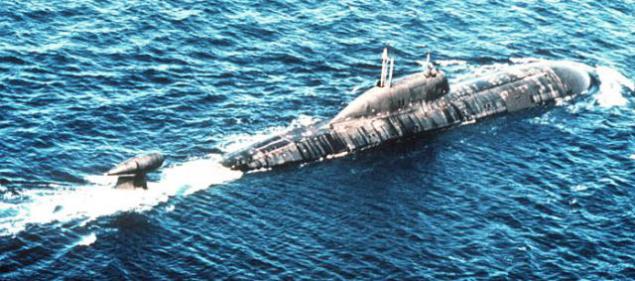
The most deep-
K-278 "Komsomolets»
K-278 "Komsomolets" - Soviet nuclear submarine 3rd generation, the only boat Project 685 "Fin." Boat absolute record belongs to the depth of immersion among the submarines - 1027 meters [1]. She died in a fire in the Norwegian Sea April 7, 1989.

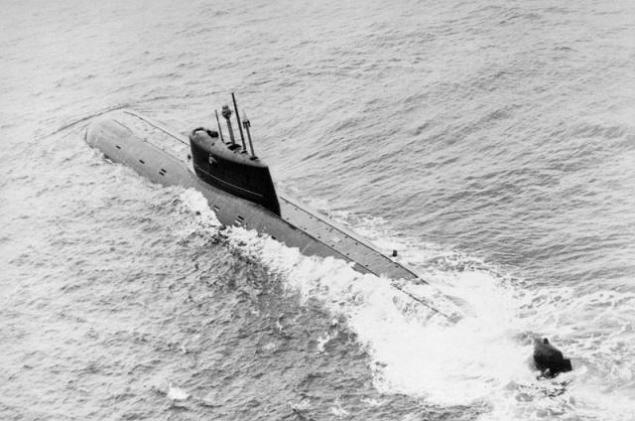
The most massive
U-Boot Klasse VII (Germany)
Submarine 7 class known not only a record number of copies (during WWII came into operation 703 car), but also a remarkable effectiveness.
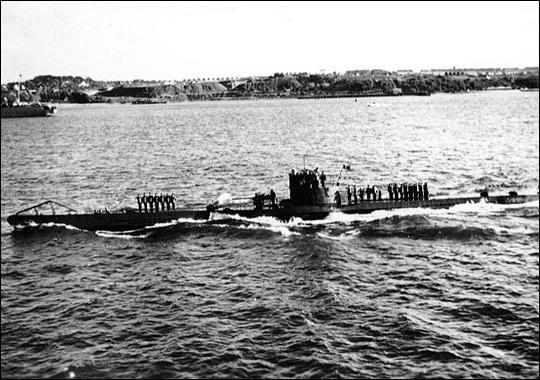
The most deadly
Project 949A "Antey»
Submarine Project 949A "Antey" - a series of Soviet and Russian submarines with cruise missiles "Granit". According to NATO classification - «Oscar-II». The main purpose of the class - the destruction of aircraft carrier battle compounds. Project 949 is a modification of the type of "Granit". Total built 11 ships out of 18 planned construction of mothballed, canceled the rest.
The huge ship with a displacement of 24,000 tons underwater. Is on board 24 cruise missiles. One of the 11 ships of the project "Antey" was the K-141 "Kursk", who was killed August 12, 2000 in the Barents Sea.
Project 949A "Antey". NS "Cmolensk."
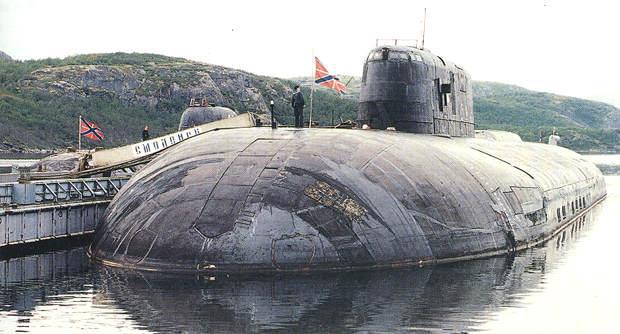

The most frightening
SSBN-598 "George Washington»
His appearance first nuclear submarine "George Washington" has completed the formation of the classic nuclear triad-modern mechanism of nuclear deterrence, in which the strategic arsenal of state-va placed on land, at sea and in the air. The ship was carrying 16 two-stage ballistic missile UGM-27 "Polaris" and can launch them at a depth of 20 meters.


The biggest submarine
Project 941 "Akula»
Heavy strategic missile submarine Project 941 "Akula» (SSBN «Typhoon» according to NATO classification) - the world's largest nuclear-powered submarines. The project was developed in TSKBMT "Rubin" (St. Petersburg). The task for the development was granted in December 1972.

Displacement underwater 49500, Length: 172.8 m., The crew of 160 people.
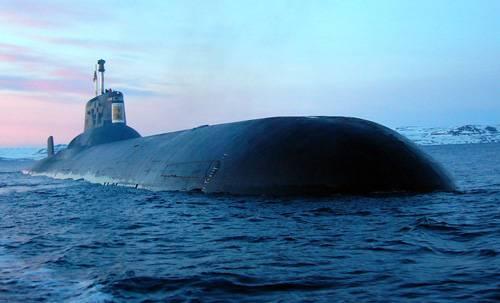
The main armament - missile complex D-19 with 20 three-stage solid-fuel ballistic missile R-39 "Option". These missiles have a maximum starting weight (together with launch canister - 90 m) and long (17, 1 m) of SLBMs taken into service. Fighting the range rockets - 8300 km, warhead - divide 10 individually guided nuclear warheads of 100 kilotons of TNT each.
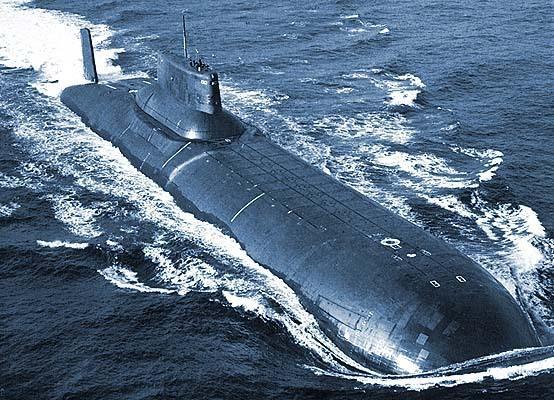
Interesting facts:
The commander of the first guided missile cruiser Captain 1st Rank AV Olkhovikova for the development of a unique ship in 1984 was awarded the title Hero of the Soviet Union.
Displacement submarine of the "Shark" is greater than the displacement of the heavy aircraft-carrying cruiser "Admiral Gorshkov».
6 submarines of the "Shark" listed in the Guinness Book of Records as the largest submarines in the world.
Armchair commander in the central office shall be inviolable, including for the division commander, fleet or fleet, and even the defense minister.
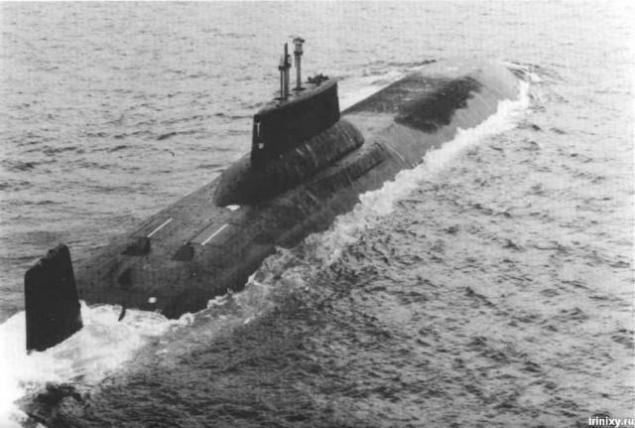
The first real submarine took part in armed actions was set up in the United States Horace L. Hunley (HLHunley) during the Civil War Confederate Navy. It was a locomotive boiler, at both ends of which are mounted pointy tip. Immersion was carried out by filling the two ballast tanks fore and aft, which were blown to ascend hand pump, and for emergency ascent dumped iron ballast is fixed at the bottom. The propeller is rotated by the crankshaft eight sailors. Armament consisted of mines, enshrined in a long steel pole on the bow of the boat. Seeing entrance and exit of the crew of the boat were carried out through two small towers.
Horace L. Hunley Confederate Navy during

The First World War
In May 1899 at an international conference in The Hague, Russia, with the support of countries such as Germany, France, Italy, Japan and the United States has attempted to limit the creation of underwater weapons, which was thwarted by Britain.
English PL.Portsmut.Pervoe decade of the twentieth century.
During the First World War there were submarines with diesel engine for movement on the surface and electric motion to the water. It was connected to a diesel engine generator that produces electricity to recharge the batteries.
Accelerated development of the submarine fleet in World War I led to the fact that the submarine became a formidable weapon. During the war 600 submarine sank the Warring States 55 major warships (battleships and cruisers), 105 destroyers, 33 submarines. Total tonnage sunk merchant ships was approximately 19 million gross tons. Actions of German submarines in the sea lanes put England on the brink of defeat in the war.
English PL.Portsmut.Pervoe decade of the twentieth century.

German UC-1. The First World War

Mine (torpedo) compartment of the submarine during World War

At the end of the First World War was concluded on the need to interact submarines with surface ships of the squadron, so between the two world wars, mainly improved surface performance characteristics.
The Second World War
By the beginning of World War II in the Navy's leading maritime nations included the following number of submarines:
Germany - 57;
US - 99;
France - 77;
Italy - 105;
Japan - 56;
USSR - ~ 200 to 22.06.1941 - 211.
United Kingdom - 58;
During the war, all submarines of foreign countries (excluding the USSR) was sunk 4,330 vessels with a total carrying capacity of transport about 22, 1 million reg. ie, destroyed 395 warships, including 75 submarines, 17 aircraft carriers, 3 battleships, destroyers, 122 and 146 ships of other types. Died in 1123 submarines.
Submarines of the Navy sank 328 transports, 70 warships and 14 auxiliary ships of enemy with a general displacement 938 thou. Tons.
During World War II Submarines perform different tasks, but at relatively the same combat capabilities of their effectiveness has been mixed. In extreme conditions, in crowded and shallow areas, the presence of a major mine risk education and the strong development of ASW combat missions had a Soviet submarine.
L-23 - Soviet diesel-electric mine and torpedo submarines during the Second World War, the fourth ship of the series XIII-1938 of the "Leninist».

L-19 (Series XIII, A - "Leninist") - Soviet diesel-electric submarine minelayer of World War II.

Submarines M - "Baby" - the type of Soviet submarines during the Second World War, the smallest submarines in the Soviet Union during this period. Submarines type "M" actively participated in the Great Patriotic War. Targeting near-coastal protection and marine bases, they were able to conduct successful operations even in the coast of the enemy in enemy harbors.


Submarines of WWII times other states:
American submarine, Type «Argonaut»

The German submarine series «VII»

U-36 (died in 1939)

U-28 (died 17.3.1944), U-29 (flooded 5.5.1945), U-30 (flooded 5.5.1945)

In his new capacity
Work on the creation of the Premier League were conducted at an accelerated pace. In 1948 the project was completed nuclear power plant and the contract for the design and construction of the experimental reactor, and in August 1949 approved the tactical and technical data of the first nuclear submarine, which was founded in June 1952 at a shipyard in Groton and named Nautilus. January 21, 1954 in the presence of US President Eisenhower's the Nautilus was launched, and January 18, 1955 was submitted for testing and the commander aired openly "Go under the nuclear engine».
USS Nautilus (SSN-571) - the world's first nuclear-powered submarine, launched in the US in 1954.

The first submarine is not only demonstrated their tactical advantages, but also put forward a number of problems. So, their displacement has increased about twice, and the cost is almost twenty times compared with diesel-electric submarines of the United States during World War II.

When you create the Premier League had, in principle, to change the approach to the choice of shape and size of the body, which for diesel-electric submarines were determined based on the regime of navigation on the surface. For Premier League, almost always under water, surface speed mode is episodic and, therefore, at its creation is necessary to strive for the greatest possible reduction in resistance of the boat submerged. Despite some progress in reducing the underwater resistance of diesel-electric. boats of the middle 40 - the beginning of the 50s, their body shape and size for the Premier League were not good. They require more drastic measures, as it was a submerged speed of 30 knots or more, in which the resistance of the water will "eat" a much greater share of the power plant capacity than diesel-electric boats with underwater speed of 10-15 knots. And the increase in capacity for every 1,000 kilowatt considering low specific mass indexes ETA was followed by an increase in the mass installation of about 80 tons.
In the USSR, the first nuclear submarine became known not without K-19.
"K-19" - was capable of carrying three nuclear ballistic missiles. The submarine was built in Sverdlovsk in record time and was a response to the emergence of the Soviet Union, the Americans missile submarine "George Washington».
Designing 658 project began in August 1956, CDB-18 under the direction of SN Kovalev. The basis was taken Project 627 multipurpose nuclear torpedo boats.
K-19 - the nuclear submarine project 658. For many boat had an accident in the Navy nickname "Hiroshima».



List of accidents and disasters at the K-19
Because of the accidents several people died in 1959, before the descent of the submarine into the water:
when painting holds a fire broke out, two people were killed;
after the resumption of paint work choked a female painter;
In 1961, when loading rockets into the mines was a sailor cap crushed mine and was killed.
April 12, 1961 the boat narrowly escaped a collision with the submarine USS «Nautilus» SSN-571, but due to a sharp decrease in the depth of the maneuver while crashing into the bottom. There was no significant damage.
3 July 1961 - an accident the reactor feed: the pressure drop in the primary circuit as a result of the gap in the first circuit control line between the pressure line and the sensor. As a result, the devices showed zero pressure, although there was a complete rupture. Eliminating accident subsequently cost the lives of eight people, all the rest of the crew received high doses of radiation.
November 15, 1969 - the collision submerged submarine USS Gato US Navy during the maneuver of changing the depth from 60 to 90 meters.
February 24, 1972 - Fire in the 8th and 9th compartments. Pribuksirovana on base. Killed 28 people on the boat and two rescuers. 12 sailors have been in prison in the 10th aft compartment 24 days without electricity, communications, food and with scarce water available from other compartments only air (intermittent). All survived.
15 August 1982 - in the repair in the battery compartment there was an electrical arc. Burned several people, one of them on August 20 at the hospital died.
Modern submarines
Modern submarines are used as a source of nuclear power plant, diesel motors, batteries, Stirling engines or fuel cells.
Submarine in the march
After the Second World War are known only two significant cases of submarine torpedoing a warship. December 9, 1971 during the Indo-Pakistani War Pakistani diesel submarine «Hangor» torpedoed Indian frigate «Khukri». May 2, 1982 during the Falklands War between Britain and Argentina, the British nuclear submarine «Conqueror» torpedoed the Argentine light cruiser "General Belgrano". In addition, the death of a South Korean corvette "Cheonan" March 26, 2010 took place, according to the conclusion of the commission to investigate the incident, as a result of North Korea's torpedoing of his submarine.
Nuclear submarine type «Vanguard.


941 missile submarine "Typhoon.


FACTS:
The most revolutionary submarine.
Project 705 - Lira
Submarine Project 705, 705K "Lira" - a series of Soviet submarines. High-speed single-shaft small boat with a titanium case had no analogues in speed and maneuverability, were designed to destroy enemy submarines. Difficulties in maintenance of submarines and the reduction of funding in connection with the beginning of perestroika led to the end of the career of these ships.

Maximum speed "Lear" is 41 knot. They are inferior in speed only decommissioned K-222 Project 661 "Anchar" which set a record speed of 44 knots 7;
For more than 20 years of service in the fight for survival has not lost a single man. None of the ships were lost;
"Lyra" could pursue any submarine and break away from any prosecution. On acceleration to full speed they needed only about 1 minute.
Speed Boat let her rip even many anti-submarine torpedoes.
The world's only serial project submarines with liquid metal reactor
On a boat this project achieved a record daily average travel speed ~ 41-42 knot.

The most deep-
K-278 "Komsomolets»
K-278 "Komsomolets" - Soviet nuclear submarine 3rd generation, the only boat Project 685 "Fin." Boat absolute record belongs to the depth of immersion among the submarines - 1027 meters [1]. She died in a fire in the Norwegian Sea April 7, 1989.


The most massive
U-Boot Klasse VII (Germany)
Submarine 7 class known not only a record number of copies (during WWII came into operation 703 car), but also a remarkable effectiveness.

The most deadly
Project 949A "Antey»
Submarine Project 949A "Antey" - a series of Soviet and Russian submarines with cruise missiles "Granit". According to NATO classification - «Oscar-II». The main purpose of the class - the destruction of aircraft carrier battle compounds. Project 949 is a modification of the type of "Granit". Total built 11 ships out of 18 planned construction of mothballed, canceled the rest.
The huge ship with a displacement of 24,000 tons underwater. Is on board 24 cruise missiles. One of the 11 ships of the project "Antey" was the K-141 "Kursk", who was killed August 12, 2000 in the Barents Sea.
Project 949A "Antey". NS "Cmolensk."


The most frightening
SSBN-598 "George Washington»
His appearance first nuclear submarine "George Washington" has completed the formation of the classic nuclear triad-modern mechanism of nuclear deterrence, in which the strategic arsenal of state-va placed on land, at sea and in the air. The ship was carrying 16 two-stage ballistic missile UGM-27 "Polaris" and can launch them at a depth of 20 meters.


The biggest submarine
Project 941 "Akula»
Heavy strategic missile submarine Project 941 "Akula» (SSBN «Typhoon» according to NATO classification) - the world's largest nuclear-powered submarines. The project was developed in TSKBMT "Rubin" (St. Petersburg). The task for the development was granted in December 1972.

Displacement underwater 49500, Length: 172.8 m., The crew of 160 people.

The main armament - missile complex D-19 with 20 three-stage solid-fuel ballistic missile R-39 "Option". These missiles have a maximum starting weight (together with launch canister - 90 m) and long (17, 1 m) of SLBMs taken into service. Fighting the range rockets - 8300 km, warhead - divide 10 individually guided nuclear warheads of 100 kilotons of TNT each.

Interesting facts:
The commander of the first guided missile cruiser Captain 1st Rank AV Olkhovikova for the development of a unique ship in 1984 was awarded the title Hero of the Soviet Union.
Displacement submarine of the "Shark" is greater than the displacement of the heavy aircraft-carrying cruiser "Admiral Gorshkov».
6 submarines of the "Shark" listed in the Guinness Book of Records as the largest submarines in the world.
Armchair commander in the central office shall be inviolable, including for the division commander, fleet or fleet, and even the defense minister.


